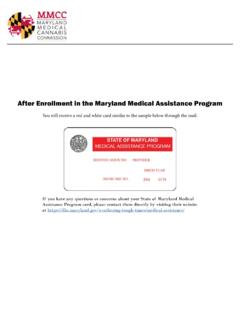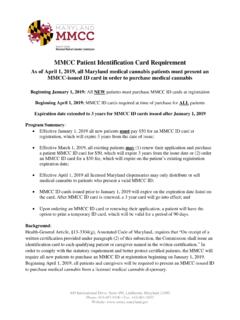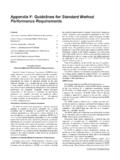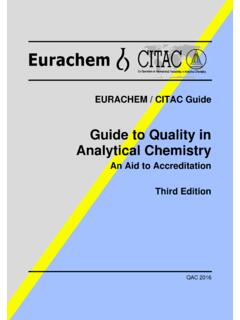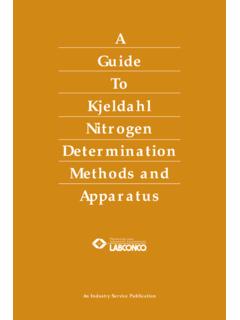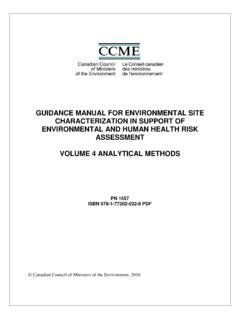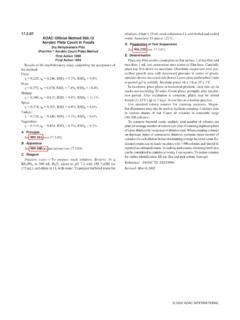Transcription of THE MARYLAND MEDICAL CANNABIS C S TECHNICAL …
1 THE MARYLAND MEDICAL CANNABIS COMMISSION S TECHNICAL AUTHORITY FOR MEDICAL CANNABIS TESTING REVISION December 15, 2020 The MARYLAND MEDICAL CANNABIS Commission (MMCC) has developed this TECHNICAL authority document to define contaminants and corresponding action limits associated with those contaminants in MEDICAL CANNABIS . This information is intended for use by the independent testing laboratories registered with the MMCC. 2 Table of Contents Introduction 3 Sampling 4 Collection Procedure for Laboratory Samples 5 Potency 6 Pesticides 7 Residual Solvents 8 Microbiological Impurities 9 Heavy Metals 11 Excipients 13 Stability Testing 13 Appendix A - MEDICAL
2 CANNABIS Testing Requirements 14 Appendix B - Definitions 15 Appendix C - Stability Testing Protocol- MMCC Licensed Grower 17 Appendix D - Stability Testing Protocol-MMCC Licensed Processor 19 Appendix E - Stability Testing Protocol-Edibles 21 Appendix F - Microbiological Quality Control 22 Appendix G- Pathogen Detection Storage Requirements 26 References 27 MMCC s TECHNICAL AUTHORITY FOR MEDICAL CANNABIS TESTING 12/15/20 3 PAGE \* MERGEFINTRODUCTION Analytical testing of MEDICAL CANNABIS for safety and potency is increasingly recognized as a critical and necessary component of the industry for several reasons (Freeman et al.)
3 2016): Laboratory testing minimizes the risk of pesticides, microbes, heavy metals, toxins, and residual solvents from being consumed by an immunocompromised population; Quantification of cannabinoid profiles and potency becomes available for the consumer and aids in determining appropriate dosing for individual use; and Laboratory testing provides a sense of public safety and product quality for the MEDICAL CANNABIS tested. The MARYLAND MEDICAL CANNABIS Commission (MMCC), with the assistance of a scientific work group, has established this TECHNICAL authority to serve as a reference guide for the independent testing laboratories (ITL) to follow when analyzing MEDICAL CANNABIS .
4 This TECHNICAL authority has the force and effect of law and must be followed by ITLs pursuant to the Code of MARYLAND Regulations (COMAR) and The contaminants in MEDICAL CANNABIS identified in COMAR and may not exceed the levels specified in this guidance. MEDICAL CANNABIS safety and potency is to be analyzed based on the most current version of the CANNABIS inflorescence monograph published by the American Herbal Pharmacopeia (AHP), or a scientifically valid methodology that is equal or superior to that of the AHP monograph. COMAR and list the quality control testing requirements for MEDICAL CANNABIS .
5 This TECHNICAL authority provides the lists of contaminants and the acceptable tolerances that the ITL is required to report as stated in COMAR and The tolerances were established following a review of available literature in the CANNABIS industry as well as references from the international Conference for Harmonisation (ICH) Guideline Q3C on Impurities and the ICH Guideline Q3D on Elemental Impurities Guidance for Industry. The four categories of contaminants identified in COMAR and include: Pesticides; Residual Solvents; Microbiological Impurities; and Heavy Metals.
6 In an effective testing program, standardized sampling procedures are an integral component to quality laboratory testing. The data generated from all analytical methods must be consistently reliable and legally defensible. To achieve this, method precision and accuracy measurements should be performed during the sample testing process. This guidance will provide best practices for sample collection by the ITL. All sampling and analysis described in this guidance shall be conducted by an ITL registered with the MMCC and in good standing and accredited to ISO/IEC 17025 by an international Laboratory Accreditation Cooperation (ILAC) recognized third party.
7 The MMCC is committed to evidence-based decision-making when implementing TECHNICAL guidance for the registered ITL. As research into CANNABIS use and safety advances, this TECHNICAL authority will be revised and updated to reflect the state of science as it pertains to the MEDICAL CANNABIS industry. MMCC s TECHNICAL AUTHORITY FOR MEDICAL CANNABIS TESTING 12/15/20 4 PAGE \* MERGEFSAMPLING The objective of a sampling procedure is to ensure the proper collection, clear labeling, proper preservation, careful transportation, and storage of samples by trained personnel for laboratory analyses.
8 Collection of the sample is critical as it must be truly representative of the material being analyzed or the results will not be meaningful. ITLs are required to develop a statistically valid sampling method and collect a representative sample from each batch or lot of final product that is adequate to perform the required testing (COMAR and ). The amount of sample required for cannabinoid or contaminant testing may vary due to sample matrix, analytical method, and laboratory-specific procedures. MEDICAL CANNABIS sampling procedures play an important role in identifying and/or confirming the integrity of a sample, as well as the completeness of request and chain of custody forms.
9 To reliably provide the laboratory with a representative sample, standard sampling methods with descriptive steps must be applied with quality and consistency. All sampling must be consistently performed using accepted methodologies. It is the responsibility of the ITL to define a standard operating procedure that minimizes both imprecision and bias and lists chronological steps that ensure a consistent and repeatable method. When sampling for compliance, all ITLs are required to follow the sampling protocol listed on page 5 of this document, Collection Procedure for Laboratory Compliance and Retention Samples.
10 In addition, the following sampling guidelines shall be demonstrated by the laboratory when performing sampling at a licensed grower or licensed processor: The use of appropriate sampling equipment to avoid contamination; The documentation of observations and procedures used during sample collection; The use of an aseptic collection technique is required for antimicrobial testing; The importance of personal hygiene and use of person protective equipment; and The method used by personnel to consistently obtain samples throughout the batch. (See Appendix A MEDICAL CANNABIS Testing Requirements for information regarding required testing for each sample matrix).
